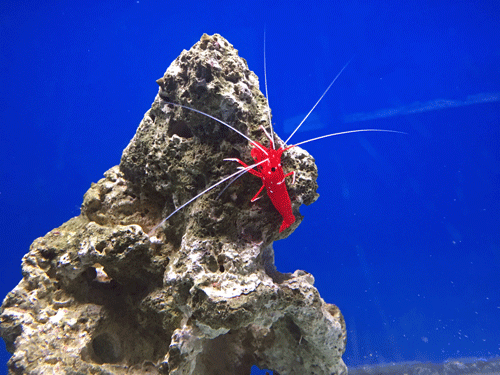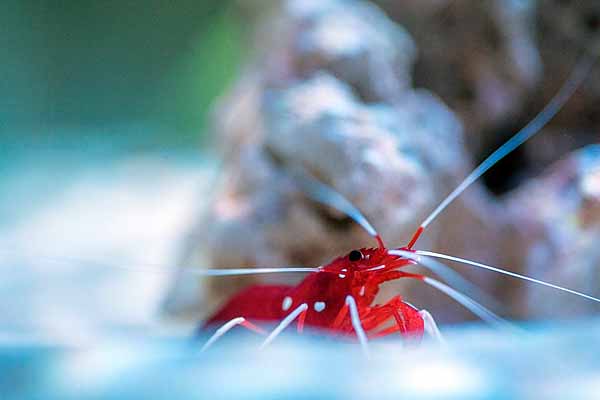[ad_1]
The Blood Red Fire Shrimp is one of the most sought-after invertebrates in the saltwater aquarium hobby–because of the amazing color, delicate gracefulness, and fascinating cleaning behavior. Don’t take my word for it, take a look at this beautiful creature. Have you ever seen such a deep red color in the natural world?
Not surprising when you see for yourself how the Blood Red Fire Shrimp gets its name
Quick facts
Common names: Fire Shrimp or Blood Red Fire Shrimp
Scientific name: Lysmata debelius
Care level: Easy
Aggression: Low – compatible with a lot of other peaceful reef aquarium inhabitants
Typical adult size: 2 inches (~50 mm)
Minimum tank size:
Is it a cleaner?: Yes, the Blood Red Fire Shrimp is considered a cleaner shrimp
Diet: Carnivorous diet, eats meaty foods, will clean up uneaten food around the tank and capture floating food
Reef safe: Yes, this animal will very likely leave your corals and other invertebrates alone. It will also get along with peaceful saltwater fish that will leave it alone (or allow the shrimp to clean them)
Most active: Nighttime is when this cleaner shrimp will be most active. During the day, you may find them on the underside of a live rock ledge, or behind it
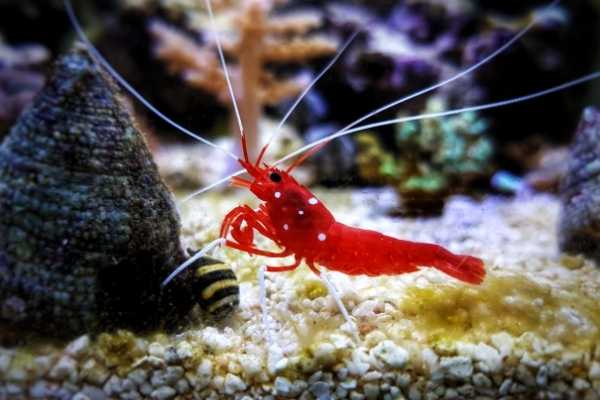
Part of the clean-up-crew but they won’t eat algae
Ideal habitat
A Blood Red Fire Shrimp will be at home in small and large tanks alike–they are perfectly suitable in a nano aquarium or large reef setup. Fire Shrimp are sensitive to nitrites and ammonia in water, so the tank should be fully cycled before introducing them and you will want to have some experience managing a saltwater tank and keeping nitrate levels down. Copper should be avoided at all costs, so remove the shrimps if any of your fish need to be treated with copper-based medicine. Copper is used to kill parasitic invertebrates, like saltwater ich, but it will also kill your shrimp. So don’t do it.
Fire Shrimp can be a bit shy and sensitive to bright light, at times, and would benefit from having some live rock structure to retreat to for safety.
The fire shrimp is considered a cleaner shrimp
The Blood Red Fire Shrimp is also considered to be a cleaner shrimp species, along with the Scarlet Skunk, Coral Banded, and Peppermint shrimps. It should set up a ‘cleaning station’ in your tank–a part of the shrimp’s territory where fish will swim up and receive a complimentary cleaning service–which means the shrimp will pick off dead scales, skin and remove parasites from the fish. Watching this behavior, in action, is one of my absolute favorite things in this entire hobby.
Check them out in action in this video below!
Feeding and diet
The Fire Shrimp doesn’t have any particular nutritional or feeding requirements that are noteworthy, per se. As mentioned earlier, they are a cleaner shrimp species and will eat parasites and dead skin off your fish. They will also scavenge and eat leftover food, including thawed frozen foods, flakes, and pellets in the tank. I’ve also heard of shrimp eating the food right out of the hand of an aquarist. If you have an ultra-clean SPS tank (low bioload, low feedings), you may want to target feed your shrimp–but otherwise, they are likely to be alright as long as your tank is sufficiently fed. You will want to monitor to make sure they are eating well and aren’t always bullied out of eating.
Compatibility
Blood Red Fire Shrimp are absolutely incompatible with hawkfish or marine bettas. I would approach adding them to any tank with a fish large enough to eat them because I have even had a relatively large flame cardinal fish swallow a cleaner shrimp whole within seconds of adding the shrimp to the tank.
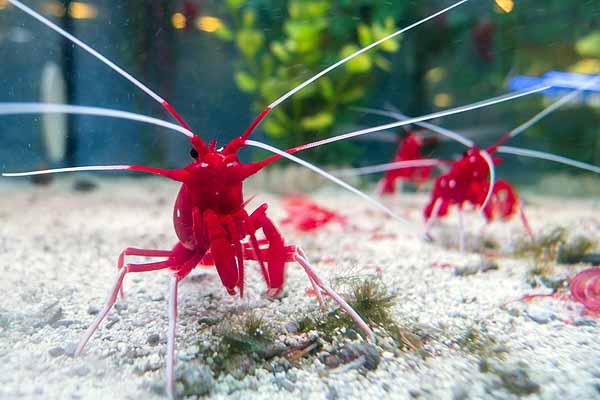
Lysmata debelius can be kept in groups or with other cleaner shrimp
Fire shrimp may also pick at some of your prized corals, so be warned, if you intend to add them to your reef tank.
Behavior and tank mates
The fire shrimp is primarily a shy, nocturnal creature, which means you probably won’t see a whole lot of them in your tank. Which is a bummer, considering how beautiful (and expensive) they are. Over time, and with some strategically timed feedings, you may be able to coax them out of hiding more frequently. ‘s you won’t see them around during strong light times. Instead, they will go out looking for food when light is off, or during dim light periods. If their other tank mates or live plants don’t actually require very strong lighting, you can provide only a small amount, so you can enjoy your cleaner shrimp more.
With the gigantic exception for the fish that will prey on and eat the Fire Shrimp, it is otherwise compatible with most other community reef fish and is probably advantageous if you are keeping fish that are notoriously susceptible to parasites, like the blue hippo tang.
Like most of the animals we keep in the saltwater aquarium hobby, there can be aggression between blood red fire shrimp or even other cleaner shrimp, like the skunk cleaner shrimp. A little shrimp-on-shrimp aggression can be expected, so it is probably best to keep one per tank.
Fire shrimp are also pretty smart and may learn to recognize you (at least as a food source). There are reports by some aquarists that their scarlet cleaner shrimp ‘greets’ them when they approach the tank or climbs onto their hand or takes food from their hand.
The shrimp I have kept, over the years, have been afraid of me, more than drawn to me, but this sounds like a pretty cool reason for me to try them again.
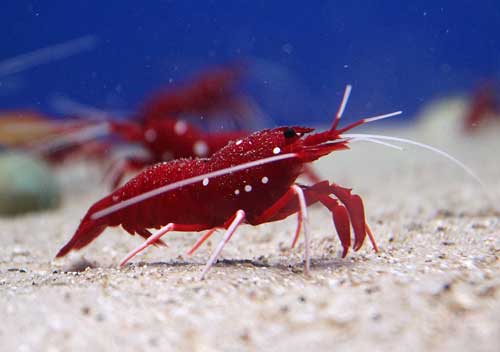
It is fine to keep more than one Fire shrimp in the same aquarium
Breeding
The Fire Shrimp has been bred in captivity. They are hermaphrodites, meaning they have both male and female reproductive organs, which means you are guaranteed to have the genetic materials needed for reproduction with any pair of shrimp. Now that doesn’t guarantee that the two individuals you get will be compatible, but it sure does suggest pairing up shouldn’t be too hard. Contrast this with saltwater fish, where you might need to buy as many as 5-7 specimens to all but guarantee a male/female connection.
Breeding any saltwater fish or invertebrates is a somewhat advanced topic. If you want to learn more about breeding cleaner shrimp, I recommend you check out two sources. The first source is a website called MOFIB. There are some helpful forum threads with important information about breeding this shrimp.
The second resource I recommend you check out is a book that I have on my own personal bookshelf, How to Raise & Train Your Peppermint Shrimp (affiliate link). Ok, so the book is written about a different species of shrimp, but many of the lessons can be applied broadly.
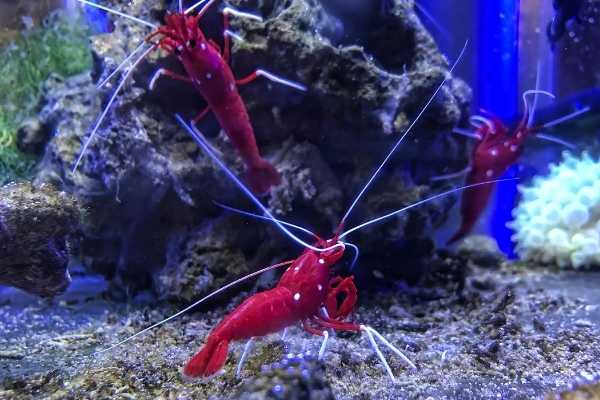
Blood red fire shrimp are hermaphrodites, so achieving fertilized eggs is easy–raising baby shrimp is the hard part
Pros and cons of keeping the Blood Red Fire Shrimp, Lysmata debelius
Like with any tank inhabitant, these shrimps also have their pros and cons when keeping them.
Pros:
- They can remove harmful parasites and dead skin from your fish
- Will help keep the tank clean by eating leftover food
- They are relatively easy to keep and don’t require any special diets or water parameters
Cons:
- May nibble at corals in reef tanks, especially during the night, when you can’t see them
- They will spend a lot of time hidden in their cave, so you may not see them around very much–the blood red fire shrimp I have in my tank only comes out in the dark and when it is feeding time
Fire shrimp vs. Cleaner shrimp (Scarlet Skunk)
So, if you are looking to buy a cleaner shrimp species, how should you decide whether to go with the Fire shrimp vs. Cleaner shrimp (Skunk)?
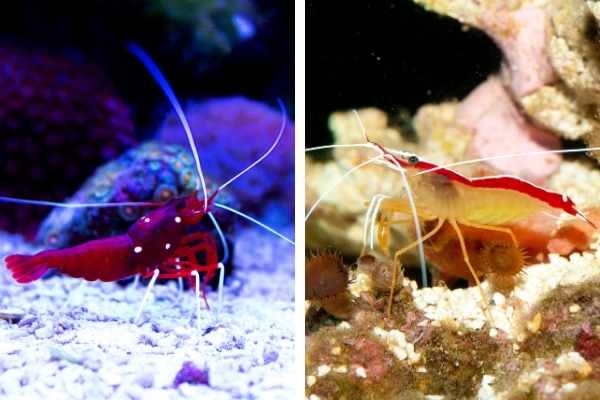
Fire shrimp vs. skunk cleaner shrimp: choose one or booth?
Here are a few things to consider:
Appearance: It’s hard to argue that both species aren’t gorgeous, but which do you think is the most beautiful? That’s going to be a personal choice. Personally, I’d take the Fire shrimp.
Price: Lysmata debelius is almost always more expensive than Lysmata amboinensis. Depending on your budget, that factor could sway you in either direction. If money is no object, then the Fire shrimp may be a bit more exclusive. If you are looking for a great shrimp at a more reasonable price, the Skunk cleaner is your arthropod of choice.
Active cleaning: How important for you is it to observe the active cleaning behavior? Based on my personal experience, the skunky cleaner shrimp with cleaner in the name gets an antenna ahead of that race.
The good news is that the two species are compatible with each other, so perhaps we don’t have to think about it as either or–why not go for both?
For more information
Check out these other great cleaner shrimp, to make sure you have the right one for your tank:
Conclusions
Adding a Blood Red Fire Shrimp, Lysmata debelius, will certainly give your saltwater aquarium a burst of color. They can be a little bit pricey and shy, but will absolutely work-for-the-money in your tank.
What has your experience been with keeping Blood Red Fire Shrimps? Please leave a comment and let me know.
After that, consider joining the newsletter mailing list. You’ll get a free gift, for signing up, and each week I’ll mail you some interesting articles from the aquarium world.
If you want to continue your journey, check out The Reef Aquarium Series of books: The New Saltwater Aquarium Guide, How to Frag Corals, 107 Tips for the Marine Reef Aquarium, and the Reef Journal.
Please leave a comment below
What questions do you have that aren’t answered here? What were your keys to success in keeping them? Please share so we can all continue to get better.
[ad_2]
Source link

